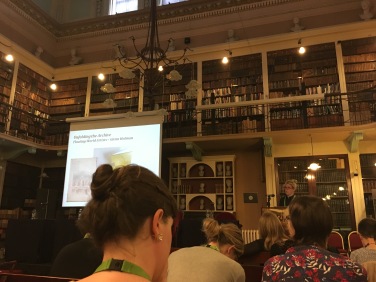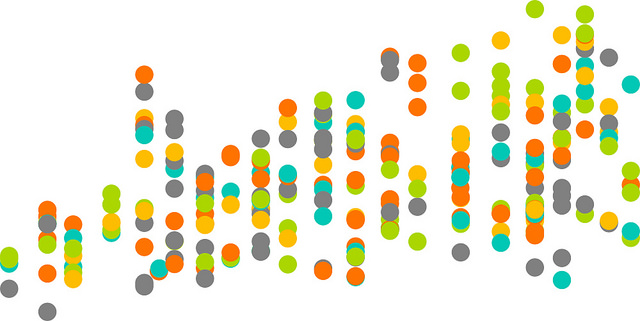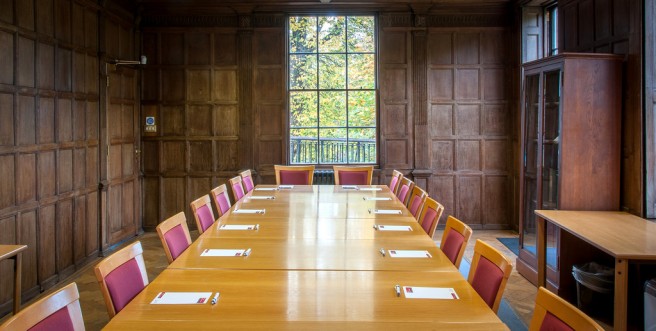This year’s Art Libraries Society (Arlis) conference took place in the historic city of Dublin from Wednesday 12 – Friday 14 July 2017. It had been 20 years since the conference was last held in Ireland and attendees from across the UK, Canada and North America received a warm welcome. The event unfolded at the recently refurbished National Gallery of Ireland and concluded at the prestigious Royal Irish Academy. A fascinating series of presentations were interspersed with visits to local places of interest, including the National College of Art & Design, Royal Dublin Society and Francis Bacon’s studio at Hugh Lane Gallery.

Day One
Keynote speech: Dr Stephen Bury, Andrew W. Mellon Chief Librarian of the Frick Art Reference Library, New York
Contesting the idea of library as rendered obsolete by electronic resources and artificial intelligence, Stephen explored a range of cases that evidenced “nothing can supplant the physical object”.
Despite bookless libraries becoming a reality in recent years, a 17% drop in eBook sales has evidenced the persistence of print. This year witnessed the online retail giant Amazon launch its first physical bookshop in New York. The popularity of Polaroid, vinyl records, cassette tape and colloid film further attests to a need for tangible mediums and phenomenon-based learning.
Stephen discussed the importance of working with our technical colleagues to develop hybrid services, online can promote print through virtual exhibitions and digitised archives. The keynote concluded with a brief exploration of the Frick Collection’s Digital Art History Lab.
Breakout 1
Artists’ Residencies in Libraries- experiences at two institutions. Gustavo Grandal Montero (UAL) & Andrew Gray (Goldsmiths)
“Artists and curators are everywhere”
Working in partnership with external agencies Bookworks and TrAIN/Gasworks, both UAL and Goldsmiths University respectively offer biannual artists residencies that culminate in an exhibition. Each residency has a research focus, provides a platform for new artists and has integrated the library into art making. For anyone starting a similar scheme, both speakers advised the following:
- Make roles and responsibilities clear
- Document from the start
- Be open to new ideas as artist outputs vary
- Advertise as widely as possible and proactively network

Connecting with Patrons, highlighting the collections, and learning about the Library: Low Cost High-Impact Makerspaces in U.S. Art Libraries. Megan Lotts (Rutgers State University of New Jersey)
Megan spoke of a wider resurgence in DIY culture and the library becoming a creative laboratory in response. Holding events is “cheap, easy and non-messy.” Workshops foster collaboration and potentially attract studio artists to the library through “tactile learning”. The following initiatives have been successful at Rutgers State University:
- Art Library colouring book to improve understanding of collections. Promoted with pop-up event and documentation of the project posted to social media channels.
- Button making to encourage students to consider copyright issues that can arise from conception to consumption. Used as part of library tours, pop-up events and collaborations with other departments.
- Lego play for health and wellbeing. Dedicated space in library for creative problem solving and 3D thinking. Changes perceptions of Library with students more likely to ask for help.
Megan observed, “not all learning comes out of a book.”

With ubiquitous access to information, why would anyone go to the Library? Beth Walker & Nancy Steffes, College for Creative Studies’ Libraries, Detroit.
When their circulation figures dropped by 58%, Beth and Nancy instigated a student project with Associate Professor of the School of Design, Van Robinson. Over 5 ½ weeks, two teams of students re-envisioned the library space as part of their course, taking the opportunity to have a significant impact on how the library functions. Each team reviewed stakeholders’ needs, produced customer journey maps and presented their designs to a panel with feasible designs adopted by the Library.
- Both designed had reduced the amount of book stock and zoned the library space.
- Both teams identified the importance of spaces for ‘cognitive breaks’ to encourage creativity and increase productivity. Team 1 has a ‘creative recharge area’ whilst team 2 had a napping area in their ‘reflective’ zone.
- Feasible designs adopted included eero-style ball chairs and study pods.
Assessing the impact of Library Instruction on Studio-based research: developing a Qualitative model. Ellen Petraits, Rhode Island School of Design.
Finding effective ways to measure how information literacy affects student learning in the dynamic studio environment is challenging. Looking at definitions of transliteracy and multimodality as well as threshold concepts (i.e ACRL) and Bloom taxonomy of educational objectives provides a useful starting point. Advanced students are expected to demonstrate a holistic understanding of threshold concepts. Ellen attends studio critiques to gain access to an otherwise closed community and is developing a post-research workshop assessment tool.
Images as Evidence: how visual literacy is overlooked in the classroom. Kirsten Schauster, Kings College London.
The printed work is often a medium that is often prioritised over others in the realm of information literacy. Yet, critical thinking and consideration of quality, authenticity and copyright when interpreting images is vital for academic success. Kirsten encouraged art librarians to engage in interdisciplinary collaboration to develop communities of practice. Visual literacy is applicable to a range of subjects from Museum studies to Performance Art.

Let’s get Physical: Supporting Arts Based Research through Haptic Learning. Christopher Jones, University for the Creative Arts (UCA).
“Practice and theory happen in the same instant.”
How can the library become more engaged with courses and arts-based research? Christopher explored Gadamer’s concept of play and phenomenology theory to support a successful proposal to establish a materials collection at UCA. The collection offers a ‘Haptic’ learning experience where students can expand their sensuous knowledge through encounters with multifarious textures. To promote the newly established collection, Christopher has completed the following:
- Acquisition of display cabinets- selecting materials based on their inspirational aspects
- Creative writing workshops requiring students to respond to particular materials in the form of poetry.
- Imaginary archaeology workshop, inspiring students to ‘bracket what they know’ and look afresh at materials.

Lightening Talks
Interactivity in the Lecture Theatre. Sarah Shenton, Manchester Metropolitan University
Sarah introduced the group to Kahoot– an interactive online quiz tool that has proven popular at student workshops. Audiences connect and submit answers through their mobile devices.
“Love you Library and your Faculty”. Alexandra Duncan, University of the Arts London
Alexandra discussed a recent project at Central Saint Martins to tackle misuse of the library space. The project resulted in an Instagram account, which has been incredibly successful.
Understanding user needs and behaviours to reassess our services. Rebecca Daniels, University for the Creative Arts.
Rebecca provided a brief overview of her MA research project carried out to understand the needs and behaviours of first year fine art undergraduates at UCA Canterbury.
Doing more with Less. Diana Caulfield, Fitzwilliam Museum.
Following a series of re-structures, Diana spoke of the trials and tribulations of running a library service as the sole Librarian and promoting the value of services to staff from other departments.
Thinking differently and asking questions: how people made voting judgements in the US elections: an art information professionals approach. Eleanor Johnston, Staffordshire University.
Eleanor visited the USA prior to the Presidential Elections and interviewed Republican and Democratic voters. The videos can be viewed online.
Day Two
Dublin City Libraries – Cultural Quarter Parnell Square. Shelley McNamara (Grafton Architects), Grianne Shaffrey (Shaffrey Associates Architects) and Angela Cassidy (Dublin City Libraries)
The Library will be the “centrepiece” of an exciting major regeneration project which will see it move from the Ilac centre to Parnell Square. Librarian Angela has contributed to the strategic plan, worked with the design team and is actively engaged in the planning process. Recommendations have included:
- An inspiring public space of collaborative learning for all ages – “an anchor for community activity”
- “Saturated with digital potential to bring collections to life.”
- A space for contemporary literature and culture. Includes spaces for performance, a music hub and visual art library.
- Multicultural, family friendly, civic meeting place and supportive of business and enterprise.
Grafton Architects spoke of their excitement to work “with people that want to make an institution that is accessible to all…really refreshing and engaging.” They described the library as a “home from home for many.” The site itself is complex, consisting of a row of Georgian terrace houses straddling either side of the Hugh Lane Gallery with multiple entrances. Proposed designs can be viewed at here.

Third Space Thinking in the Reimagined Art & Design Library. Dr Kristina Keogh, Ringling College of Art and Design
“Creativity doesn’t happen in a vacuum, nor can it be contained to discreet locations.”
In reviewing and planning operations of the new Alfred R. Goldstein Library, Kristina has been guided by Homi K Bhabha’s Third Space theory. Kristina described Third Spaces as “open, symbolic, playful and productive.” Libraries hold potential to be indeterminate spaces offering discovery and adventure to individuals finding their creative path. The Goldstein Library has evolved through collaboration with its users, with good practice identified as:
- Designer furniture that appears to have lept from the pages of design books.
- Coloured walls used to encourage art students to reflect on its interactions, i.e. pink and orange bounce of one another.
- Mural designed by former student as part of a competition.
[Re]placing the Library Space. Daniel Payne, OCAD University Toronto
Daniel mapped the stages of Kuhlthou’s Information Search Process to Lefebrvre’s triad of conceived, perceived and used space. Expanding upon this, the progressive stages of Kulthou’s model can also be linked with resources initiating with encyclopaedias to selecting books and exploring journal databases through deductive reasoning. The use of Wikipedia is discouraged, as students are not likely to contextualise their topic within an academic framework appropriately.
Transferring conceptual models to library instruction models has resulted in a number of site interventions at the Dorothy H. Hoover Library. Student projects have included a ‘proposed new rule’ and literal ‘book worms’, more at http://ocad.libguides.com/libraryinterventions
False Dawns and Premature Endings: The New DIT Library at Grangegorman. Dr Philip Cohen, Dublin Institute of Technology
DIT plan to move from a 30-campus model to a single “super campus” in Grangegorman, the largest HE development to date in Ireland. Philip identified the importance of “always look[ing] towards the future” when a series of unfortunate political obstacles threatened the project’s realisation. The new campus library will be the “academic hub” and “beating heart of the campus” offering exhibition spaces, a public café, academic support to 20,000 students, study spaces and book collections. A useful website for anyone designing a new library can be found at http://designinglibraries.org.uk/
The Fleet Library at Rhode Island School of Design: Asserting Place while creating a Commons. Mark Pompelia, Rhode Island School of Design.
The impressive Fleet Library was constructed in a former bank in 2002 and is host to a myriad of events. These include student performances, fashion shows, architecture tours and radio shows. All events are promoted alongside the Library collections on a Digital Commons website, which offers enhanced user analytics allowing staff to gain a better understanding of information behaviours.
Visit to the National College of Art & Design (NCAD), Dublin
The college moved to its current location in a former distillery on Thomas Street in 1981 and the Library was founded by Edward Murphy. The library houses some 100,000 books, a range of journals and provides online resources. Addressing the dearth of Irish art in the canon, the library has also collected a wealth of newspaper cuttings and ephemera.
This slideshow requires JavaScript.
Distillers’ Press Tour
The Press specialises in letterpress technology and has a focus on type with over 450 wooden and metal cases available from point 8 to 200. It is home to an array of working printing presses dating back to 1833 and is open to staff or students for research and experiment. Staff have observed a “move away from the monotony of the screen” and a desirability amongst the student body for tangible and tactile mediums.

Aideen Berry – Visual Artist and Academic
Aideen’s work sets out to challenge our perceived realities and her meticulous attention to detail is partly informed by her OCD. It took 46,000 photographs of Aideen jumping to create the work ‘Levitation’. Her oeuvre comprises a range of media including stop-motion animation, sculpture and installation. Talking on the interplay of art and literature, Aideen sources archival material to inform her practice, has produced works in response to specific texts and has had books published. Aideen has donated her sketchbooks and successful project proposals to the NCAD Library to inspire future visual artists.
Day Three
Keynote Speech. Chester Beatty Library: Exploring Cultural Diversity and Identity
“In learning about others, we can learn more about ourselves.”
The Chester Beatty focuses on global artistic heritage, welcoming up to 8,000 visitors a year. Operating primarily as a museum, collections are world-renowned consisting of artefacts from as far afield as Thailand, Burma, Nepal, China and Japan. Ireland’s increasingly diverse population is recognised by the provision of multilingual tours, and an outreach programme developed with the Asian Association Exchange. A recent exhibition explored national identity to foster intercultural understanding and mutual respect. It is a “centre for dialogue and learning.”
In the Service of Artists- symbiosis and creative engagement in collections development strategy at National Irish visual Arts Library. Donna Ramano, National College of Art and Design, Dublin
Donna discussed the regenerative potential of the library from contribution to collaboration. The National College of Art & Design have been involved in several projects, including Floating World where artists produced books in response to material from the Archive. These works were exhibited and added to the collections to inspire others.
Research Irish Art in it’s educational context. John Turpin, Art Historian
The first art library of Ireland was unfortunately burnt down during the Easter uprisings. This loss of documents and primary source material (“the bedrock of art research”) on Irish art left a chasm in the canon. John spoke of the subsequent development of NACD and his experience accessing National Institutions in London to research Irish art.

Art and Architecture of Ireland Publication.
Dr Nicola Figgis, Hugh Campbell and Niamh Mongey provided a detailed description of the work undertaken to publish the 5-volume set of books entitled The Art and Architecture of Ireland– ISBN 9780300179248. The title has recently been made available through JSTOR.
Visit to the Francis Bacon Studio, Hugh Lane Gallery
Relocated from Reece Mews Studio in London, Francis Bacon’s visually cacophonous studio now resides at the Hugh Lane Gallery where several of his paintings hang in adjoining rooms. This tremendous endeavour saw 7,000 items (including the walls, doors, ceiling and floor) catalogued and reassembled precisely as left by the late artist. Explore the slashed canvases, paint encrusted furniture and well-thumbed books on the dedicated database.

Many thanks to the organisers, contributors, sponsors and speakers for a fascinating few days. For future Art Libraries Society events visit their website.
Write up by Rebecca Daniels, CILIPinKent Communications Officer
Email: CILIPinKent@gmail.com



































